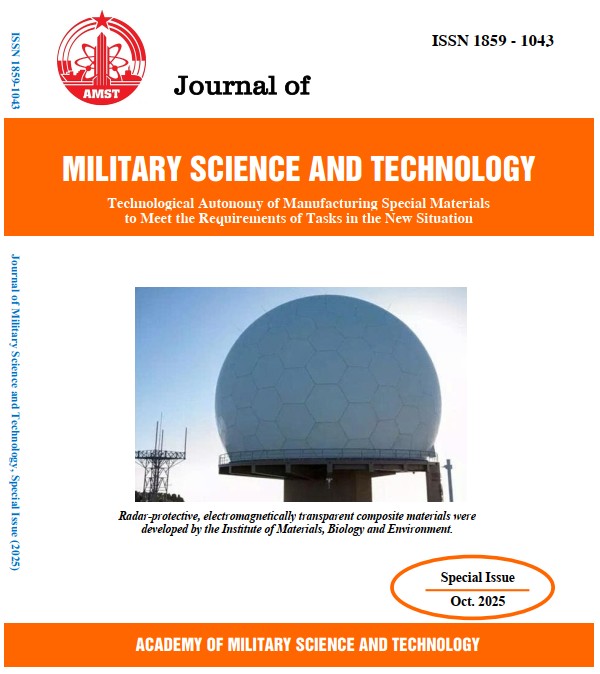Development of a rapid detection paper for cyanide ions in aqueous solutions using an organic reagent
DOI:
https://doi.org/10.54939/1859-1043.j.mst.IMBE.2025.43-49Keywords:
Cyanide; Blood agents; Toxicity; Indicator.Abstract
Cyanide is a toxic chemical agent classified as a blood agent, which has been previously used in warfare and acts of terrorism. Cyanide exerts its toxic effects primarily by inhibiting cytochrome oxidase (complex IV) in the mitochondrial electron transport chain, which is essential for aerobic cellular respiration. Numerous methods based on colorimetric reactions have been investigated for the detection of cyanide poisoning; however, these techniques typically suffer from low sensitivity, prolonged detection times, and safety risks due to direct exposure to the chemicals. This paper presents a novel method for detecting cyanide in aqueous solutions. Under the established optimal conditions, cyanide was detected with a low detection limit of about 20 ng/mL. This method has the potential to be developed into a rapid on-site detection kit for cyanide in aquatic solutions.
References
[1]. J. I. Lachowicz, J. Alexander, J. O. Aaseth, "Cyanide and cyanogenic compounds - toxicity, molecular targets, and therapeutic agents," Biomolecules, 14(11), 1420, (2024).
[2]. R. Bhattacharya, S. B. Flora, "Cyanide toxicity: molecular mechanisms and countermeasures," Indian Journal of Medical Research, 141(6), pp. 769–781, (2015).
[3]. W. Muderawan, I. W. Karyasa, I. N. Tika, G. A. B. Widana, "Chemistry and biology of cyanides: a literature review," Indonesian Journal of Chemistry and Environment, 6(2), pp. 63–82, (2023).
[4]. D. V. Becker, S. J. McGrath, M. T. O’Connor, "Industrial applications of cyanide: gold extraction and environmental considerations," Journal of Environmental Chemistry, 32(4), pp. 451–463, (2025).
[5]. J. Doe et al., "Sodium nitroprusside as a cyanide-containing precursor in antihypertensive therapy: pharmacology and clinical applications," Journal of Clinical Pharmacology, 60(5), pp. 789–798, (2025).
[6]. R. Aulicky, V. Stejskal, M. Dlouhý, J. Lišková, "Potential of hydrogen cyanide (HCN) fumigant for control of mill and wood-infesting pests," Czech Journal of Food Sciences, 33(1), pp. 97–104, (2015).
[7]. M272 Chemical agents water testing kit, NSN 6665-01-134-0885, Luxfer Magtech Inc., (2020).
[8]. K-54 Analytical Equipment Set - User Manual, Technical Department, (1993).
[9]. Ministry of Health, “QCVN 01-1:2018 - National Technical Regulation on Drinking Water Quality”, 21 pages, (2018).
[10]. N. M. Tri et al., "Research and development of a kit for the rapid detection of cyanide in water using p-nitrobenzaldehyde and o-dinitrobenzene reagents," Journal of Military Science and Technology, 88, pp. 81–86, (2023).
[11]. L. Chen et al., "Cyanide ion colorimetric chemosensor based on protonated merocyanine in EtOH," Tetrahedron Letters, 55, pp. 3017–3023, (2014).
[12]. TCVN 7723-1:2015, “Water quality - Determination of total cyanide and free cyanide using flow analysis method”, (2015).







